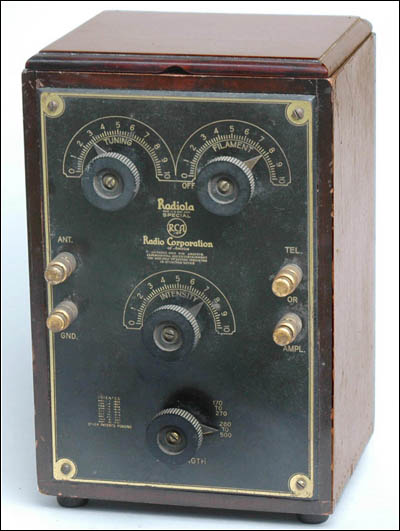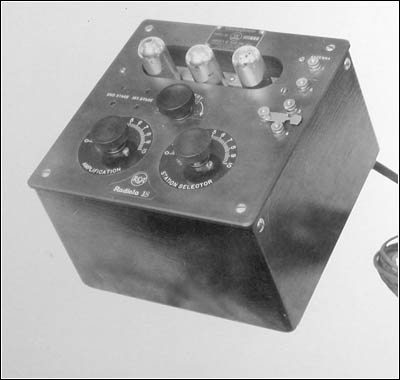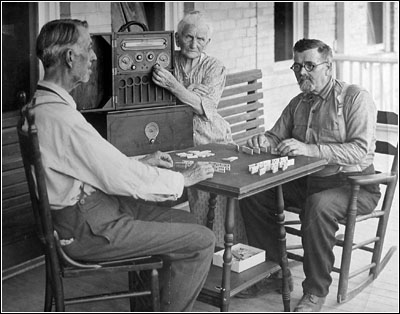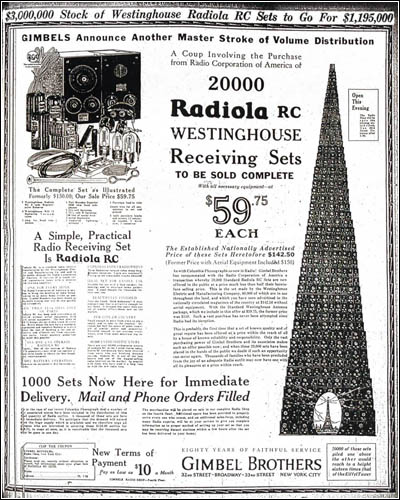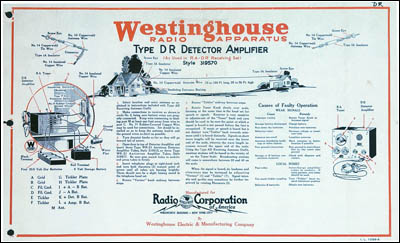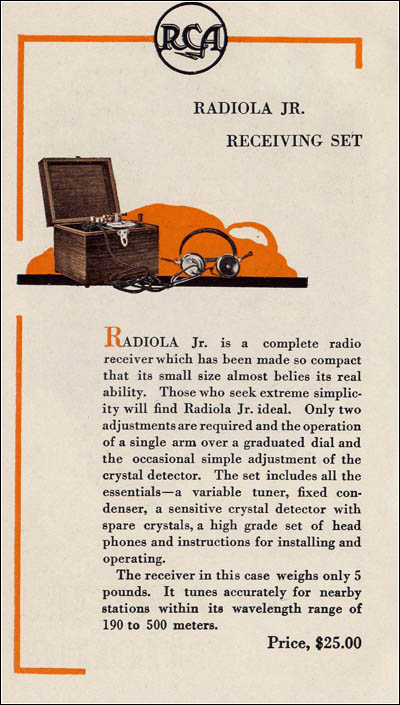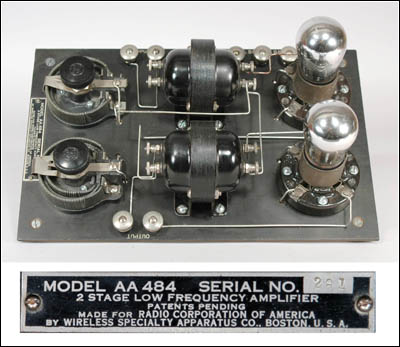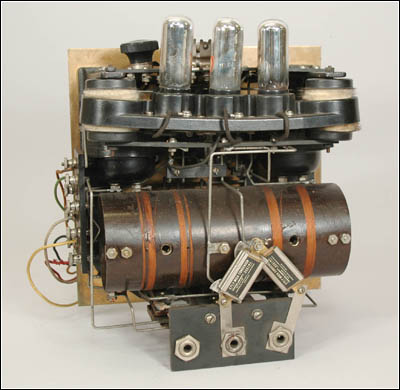Of Old Radios And Related Items--Published Monthly
Radiola -- The Golden Age of RCA
The Writing ProcessBy ERIC P. WENAAS
Web Edition
The content and quality of Eric Wenaas's book on Radiola so impressed us that we asked him to write an account of the process of writing it. Here he describes the extensive labor involved in his five years of work -- obviously a labor of love. (Editor)
Radiola is a book that I had wanted to write for a very long time--long before I retired and had the time and wherewithal to pursue my vision. The basic concept from the outset was a comprehensive pictorial book in color focusing on Radiola apparatus and associated advertisements, brochures, and instructions. The material would be supplemented by text to provide a historical context for the apparatus. It was to cover the first decade of RCA up to the time RCA merged with the Victor Talking Machine Co. and began operations under the RCA Victor name, after which the Radiola name was no longer used exclusively on RCA broadcast apparatus.
Figure 1. This very rare example of a Radiola Special one-tube receiver from the Stew Oliver collection was manufactured by Wireless Specialty Apparatus with gold-filled panel trim and a chassis with dimensions that fit a special wood case with which it came. It was not the ubiquitous metal case used on standard Specials. (Radiola, p. 197)I had already collected a large number of Radiola sets and associated literature from the 1920s by then. I thought I could rather quickly complete my collection to the point where I would have most of the sets and associated literature needed to produce the detailed color photographs -- the main theme of the book. I had also identified fellow collectors with apparatus not already in my collection who might provide images or allow me to photograph their apparatus, such as the factory-made, wood-cased Radiola Special owned by Stew Oliver, shown in Figure 1.
The Radioana Collection
The last remaining obstacle was finding a source or sources of information from which I could draw to provide original and interesting text with a unique spin. The obvious place for original information was the George H. Clark Radioana Collection at the Archives Center located in the Natural Museum of American History, Behring Center, Smithsonian Institution. This collection includes original documents, photographs, and other memorabilia from RCA and selected affiliates with cross-licensing agreements -- Westinghouse, GE, Wireless Specialty Apparatus, International Radio and United Fruit -- the so-called "Radio Group."
Figure 2. This three-tube Radiola 18 prototype closely resembling the two-tube Radiola III -- a surprise find from the Radioana Collection -- was produced by American Westinghouse for RCA, but never distributed in the US; however, the author believes the design was licensed to Canadian Westinghouse and Canadian GE for the production of Models 53 and 93, both of which were distributed in Canada. (Radiola, pg. 233) (George H. Clark Collection, Smithsonian Institution)My first visit to the Archives Center was in May of 2002, and I distinctly remember being stunned by the contents of the 15 or so boxes I was able to examine that day -- a very small fraction of the over 500 boxes in the collection. It was then and there that I knew I would write the book.
Over the next three years I made 18 visits to the Archives Center and collected over 5,000 documents and images. Many of them I had never seen before, such as the fascinating Radiola 18 prototype, shown in Figure 2. The prototype is unrelated to the Radiola 18 later marketed by RCA. Figure 3, a photograph of two men playing checkers and an older woman in the background adjusting a Radiola 26 is an example of a wonderful photograph that just could not be included in the book.
At first, I used the Archive's copy machine, but quickly switched to a digital camera to allow copying of such a large number of documents in the relatively limited time available. The large number of images quickly became overwhelming, forcing me to set up a computerized system to organize, store, and quickly retrieve information as needed during the writing process.
Figure 3. A large number of interesting and sometime humorous photographs such as this image --apparently a candidate for an RCA Radiola 26 advertisement -- could not be included in the book due to space limitations. (George H. Clark Collection, Smithsonian Institution)I found a number of documents that were different in detail from published accounts of certain historical events, and so I was able to use these documents to add a new spin to certain of my accounts. One of the more interesting documents was an interview with Frank Conrad by George H. Clark regarding Conrad's phonograph concerts from the wireless station in his garage just prior to the creation of KDKA.
Quotes from this document appearing in the book (Radiola, pages 69-71) clearly show that Conrad was making his concerts to avid Ham radio operators with bootleg receivers well before the official ban on reception was lifted on April 15, 1919. This means that Conrad was broadcasting his concerts using his wartime license (as opposed to his Amateur license 8XK as universally reported by historians) well before the earliest date reported by any historian, or even by Westinghouse -- and well before his 8XK Amateur license could have possibly been reissued after the war!
Figure 4. A large number of interesting and historically significant ads are buried away in local newspapers; for instance, this ad by Gimbels appearing in the July 23, 1923, issue of "The New York Times" advertised a whopping 20,000 RC receivers for sale at a huge discount of $59.75 each, all of which were sold within one week. (Radiola, pg. 92)The reason for the obfuscation of the dates of these concerts could easily be inferred from the interview: "Up to then [April 15, 1919] not much had been said about his sending and about the illegal receiving, for people did not want to advertise that they were using their receivers in defiance of the Government's ban" (Radiola, p. 70).
The FTC and
The Town CrierWhile the Radioana Collection may be the most extensive source of original material on early RCA, it is by no means the only one. Two sources in particular provided valuable insights into the decision processes at RCA and other companies with cross-licensing agreements -- the 4,000 pages of testimony taken at the Federal Trade Commission (FTC) investigation into allegations of a monopoly by RCA and cross-licensees, and The Town Crier, a periodical published by RCA for its distributors and retailers. Unfortunately for historians and collectors, these two sets of documents are quite rare and very difficult to find, but I was very fortunate to come into possession of both.
Figure 5. The existence of a DR resistance-coupled amplifier instruction sheet with the RCA logo and the identification I.L. 1098-A -- the "A" indicating a second printing -- is convincing evidence that the DR was mass-produced by Westinghouse and distributed by RCA. (Radiola, p. 99)As an example of insight from the FTC hearings document, Westinghouse Patent Counsel Le Roi J. Williams candidly testified that despite RCA-controlled patents on vacuum tubes, Westinghouse had decided to take the risk of selling the RA-DA apparatus to the public immediately after the first KDKA broadcast in November 1920. It used 10,000 Moorhead tubes purchased "with full knowledge that it had not any right to use those tubes in those sets, and with a full knowledge that the seller probably had no right to dispose of those tubes to the Westinghouse Company for that purpose." (Radiola, p. 116)
As another example from RCA's Town Crier, one can easily infer that RCA replaced the "sensational 17" midway into the 1927-28 season with the "new and improved" Radiola 18. The replacement was necessary not because the "17" was "sensational" or "wonderful" as claimed in ads to the public, but because the design was an abject failure due to widespread and uncontrollable oscillations that could not be fixed without markedly degrading sensitivity.
Figure 6. Most collectors are unaware that RCA changed the name of the Aeriola Jr. in the summer of 1922, and actively advertised and marketed it as the Radiola Jr. for about six months before discontinuing the set in early 1923. (Radiola, p. 105)The Town Crier went on to say that dealers reported that the most desirable feature of the new Radiola 18 was a compensating capacitor that could be adjusted by the dealer at the time of installation to maximize sensitivity and prevent oscillations. Not surprising! (Radiola, pp. 294-296.)
Other Print Sources
Other more available sources included a number of contemporary magazines such as RCA's house organ The Wireless Age, as well as newspapers such as The New York Times. I found a number of interesting ads in The New York Times such as the clearance sale of a whopping 20,000 RCs offered by Gimbels, shown in Figure 4. These sold out in one week. This ad was followed by a second ad offering another 2,000 RCs described as an "RC of the RA + DA type slightly different (but equally as good as) these we sold last week." (Radiola, p. 92)
Figure 7. This photograph of an extremely rare Wireless Specialty AA-484 2 Stage Low Frequency Amplifier taken by the author is one of his favorite shots. (Radiola, pg. 159)At first, it was very time consuming to find these ads on microfiche at the local library, but later I discovered quite by accident the Article Archive feature on the Times website. This could be word-searched all the way back to 1851, including advertisements as well as articles, making the task of finding ads and other historical tidbits much easier.
Collectors' Help
I was able to obtain some very interesting paperwork from fellow collectors along the way, the most surprising of which was an original DR resistance-coupled amplifier instruction sheet -- something I never knew existed. I obtained a low-resolution copy early in the project, but it was not sufficiently legible for publication. I was told the original had been misplaced, but was assured it would soon be found.
As time passed, the instructions could not be found, and it became necessary to finish the book layout without the instructions. It was not until after the target completion date for the book had passed that the original instruction sheet, shown here in Figure 5, finally turned up, and it was too late to change the layout. The result was that several paragraphs of text were compressed into a single short sentence to make room for this important document, which provides virtually conclusive proof that the enigmatic DR was a mass-produced factory model marketed by RCA.
Figure 8. This photograph of an altered Radiola IV with two very unoriginal capacitors bridged together in the lower center of the image almost made it into the book.Another interesting piece of paper that turned up was a sales brochure for the Radiola Jr. (as opposed to the Aeriola Jr.) -- a name that most collectors are unaware that RCA used to market this crystal set. The Radiola Jr. brochure is shown here in Figure 6.
Photographing
The next challenge was photographing the interior and exterior of all the sets, not to mention the advertising material, instructions and brochures. At the beginning, I was a novice photographer and had no experience with post-processing software. With a new Nikon SLR in hand and a crash course in "Photoshop," I began the daunting task of photographing apparatus for each chapter as it was being written. Both writing and photography followed the chronological layout of the book.
Over a three-year period, I took tens of thousands of shots (discarding most of them), and in the process, I stumbled upon a number of techniques to improve the photographs, most of which were probably already known to professionals. One of my favorite shots, Figure 7, is that of an extremely rare Model AA-484 amplifier in which the four flood lights used for illumination produced an interesting reflection from the two tubes evocative of multiple filaments (which, of course, these tubes do not have).
From time to time, I found sets in my collection which had been altered in some way, and it was always a challenge to identify and correct the alterations before photographing the apparatus. I was aided in the task of identifying alterations not only by carefully comparing the photographs with a very large collection of images gathered from fellow collectors and various Internet web sites, including auction sites, but also by the sharp eyes of a reviewer and the publisher. On several occasions, unnoticed alterations slipped by my screening process, and the sets had to be rephotographed later. One shot of an obviously altered Radiola IV, shown in Figure 8, almost made it into the book, and I was saved from embarrassment only by the keen eye of a reviewer.
Radiola contains exterior and interior photographs of all the broadcast receivers manufactured by RCA prior to 1930, plus much more. Examples of early apparatus appear on the front cover of Radiola and are also reproduced on the front cover of this issue of A.R.C. Rather than reproducing additional examples of the more familiar RCA apparatus from the book, for this article, I have selected images of apparatus and printed material rarely, if ever, seen by collectors and/or as yet not chronicled. In addition, I include several of many images that never made it into the book due to lack of space.
I hope you have enjoyed this short synopsis of how the book was prepared, and I also hope that you will have a chance to read or review the book. I would like to acknowledge all those who helped me in this endeavor, but none more than Sonoran Publishing's George A. Fathauer for his confidence in the project from the outset, his diligence and his attention to detail. The learning process for the early history of RCA will never be quite complete, and so I invite you to e-mail me with any additional information or photographs that you may wish to share (admin@chezwenaas.com).
(Eric Wenaas, Del Mar, CA 92014)
Eric P. Wenaas's lifelong passion for antique radios began with his first Radiola and crystal set given to him when growing up in Chicago. A graduate of Purdue University, with B.S. and M.S. degrees in Electrical Engineering, he holds a Ph.D from the State University of New York at Buffalo. Since retiring in 2002, he has focused on researching early wireless history and completing his collection of 1920s RCA receivers, as well as writing "Radiola -- The Golden Age of RCA."
| [Free Sample] [Books, etc., For Sale] [Subscribe to A.R.C./Renew] [Classified Ads] [Auction Prices] [Event Calendar] [Links] [Home] [Issue Archives] [Book Reviews] [Subscription Information] [A.R.C. FAQ] URL = http://www.antiqueradio.com/Aug07_Wenaas_Writing.html Copyright © 1996-2007 by John V. Terrey - For personal use only. Last revised: July 30, 2007. For Customer Assistance please contact ARC@antiqueradio.com or call (866) 371-0512 toll free Pages designed/maintained by Wayward Fluffy Publications
Antique Radio Classified |
